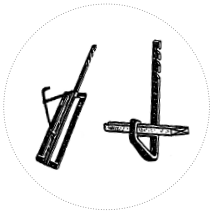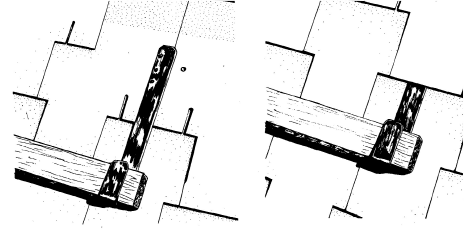
Roof Brackets
 Roofing brackets are used on steep roofs as movable supports for roofers. The bracket holds a plank which the roofer works from. Some considerations when using roofing brackets are:
Roofing brackets are used on steep roofs as movable supports for roofers. The bracket holds a plank which the roofer works from. Some considerations when using roofing brackets are:
- The brackets need to be constructed to support the loads that may be applied to them.
- Brackets need to be provided with effective non-slip devices.
- Install the brackets by securely nailing them to the into the rafters if possible. Position the brackets that a shingle can be applied over them removing the bracket, tap the bottom of the jack with your hatchet until the bracket comes loose. Then lift the shingle and drive the nails down.
Sometimes crawl boards or roof ladders are used on steep roofs as well. These devices must be securely fastened over the ridge of the roof. Never use the eaves trough to support a roof ladder.
Roof Jacks
One of the simplest and the most widely used roof jacks is the flat 38mm x 89 mm (1 ½ in x 3 ½ in) jack. On the average house with 1:1 pitch or less, this type of scaffolding is easy to use and safe, providing that the 38 mm x 89 mm (1 ½ in x 3 ½ in) has a straight grain and is not over 3 m (10 ft) long. A board that is turned on edge is much stronger than a bigger board laid flat.
Another popular roof jack is the solid 38 mm x 189 mm (1 ½ in x 7 ½ in) jack that allows you to slip in a 38 mm x 189 mm (1 ½ in x 7 ½ in) board. These jacks are built so that the board is perpendicular to the roof, thus allowing the roofer to walk on the flat part of the board. Don’t use a board that is too long. Handling a long heavy board may be unsafe on a steep roof. Note: These types of jacks may not meet the requirements of the applicable provincial Occupational Safety and Health Act.
When you nail down the roof jacks, always drive the nails where they will be covered later when another shingle is laid. The best way to remember this is to always drive the jack nails where you drive shingle nails in the shingle.

The roof jack should be positioned so that you can easily lay a shingle over it. Always use long nails to anchor roof jacks and make sure that these nails hit something solid. When you finish with the roof you should start at the top and remove the jacks in the opposite order that you installed them. With the jacks, you can remove the board and with your hatchet, tap upward on the bottom of the jack until the jack falls free. For a smoother roof, it is a good idea to raise the tabs covering the jack nails and drive the nails down flush.
Which roof jacks you use will vary depending upon what is available in your area and what is needed on your particular job. But don’t try to get by with inadequate jacks. Select good straight grain lumber and test every board before using it. If you use boards over 3 m (10 ft) long, you should install an extra jack in the middle of each board.
Remember that you will probably have the extra weight of a bundle of shingles on the board. Be sure to not overload any one scaffold board.
